At the end of the leveling and finishing of the ceiling, a decorative strip - a plinth - is installed along its perimeter. The product is necessary to hide sharp corners and give the surface a beautiful, finished look. After that, property owners have to deal with the issue of painting the profiles. Many people think that this is not necessary, and in some cases such a decision is justified. But in most situations, painting the skirting board is simply necessary. There are several reasons for finishing lamellas and a wide variety of ways to accomplish this process.
The need to paint the ceiling plinth
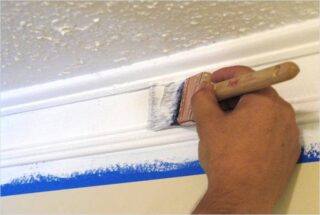
Arrangement of ceilings with plinths is not used in places where the appearance of the room does not matter due to its intended purpose. These are technical rooms, sheds, change houses and workshops. In living quarters, these products are an indispensable element of the interior and design. As a rule, white profiles are on sale. Finding other shades, especially in small towns, is quite difficult.
Planks are made of polystyrene, polystyrene, polyurethane, less often from solid wood. Even if the ceiling is white, fillets need additional finishing.
Reasons to paint your ceiling plinth:
- The surface of cellular materials is porous and loose. Vapors and dust deposited on them are absorbed, due to which the planks acquire a dirty gray tint. The presence of paint helps prevent darkening and can easily remove dirt from them.
- The foam skirting board shines through in the light, which does not make it representative. Polystyrene-based products turn yellow from ultraviolet radiation. The paint eliminates these disadvantages.
- During transportation, storage and installation, dents and scratches may appear on fillets. The thick solution masks them so well that it is almost imperceptible after the treatment of defects.
- The panels are produced in sections of 200 cm. Joints are inevitable, which are sealed with putty or glue. If you do not paint the ceiling plinth, such places will be conspicuous.
- White fillets are not always combined with other surfaces. Empirically, you can select and apply the most suitable color for specific coatings.
A separate topic is the need to paint wood products. Experts are unequivocally in favor of holding it. A preliminary and topcoat will help protect the wood from dampness, insects, ultraviolet radiation, and adapt the plinth to the style of the room.
Best time to paint
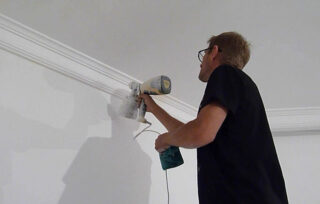
It is difficult for people who are faced with repairs for the first time to decide on the choice of stage at which it is best to carry out the painting work. The correctness of the decision is important here, since there is a risk of spoiling the decoration of the ceiling or walls.
The options can be as follows:
- Before installation. It is much easier to manipulate the profile below, on a flat and stable surface, without balancing on a ladder. In addition, fragments can be adjusted in length and corners. However, the joints will still remain, they will have to be smeared and painted. And this is the risk of staining the adjacent surfaces.
- After installation.This procedure is much more complicated, but it allows you to achieve better results, since the installation is carried out directly in the corners, and the staining is carried out simultaneously and evenly. If the ceiling and walls are already ready, you will need to take measures to protect them from accidental drops and smears.
- Immediately the ceiling and the baseboard. This is done when both objects are painted in the same color scheme. First, the profile is attached, the cracks are covered, and then the general processing is carried out. If the wall is already framed, a wide masking tape is glued to it.
In all cases, the skirting paint must be applied to the surface treated with a primer suitable for the material. This improves adhesion, reduces finish consumption and prevents flaking.
Paint selection rules
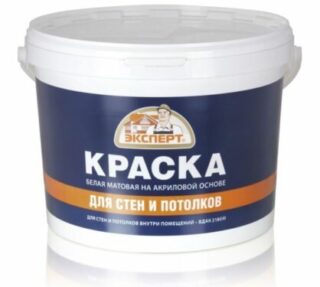
For finishing work at home, you need to choose a mixture with a corresponding mark on the package. A prerequisite is the absence of toxic emissions and fire safety. Avoid purchasing finishes that include acetone and white spirit. They are destructive to polystyrene.
The following types of paint for foam ceiling plinths are presented in the trade network:
- Acrylic. Great for all synthetic and natural materials. The acrylic coating is durable, environmentally friendly, fade and fade resistant, waterproof and durable. Well suited for rooms with high humidity, are not susceptible to mold and mildew.
- Latex. After application to profiles and drying, the composition forms a dense waterproof film on the surface. The coating can be washed with household detergents. Therefore, it is used in places with high humidity and fatty fumes. A limitation on the use of latex profiles in the kitchen is their tendency to fade from sunlight.
- Water-dispersive. They are an emulsion consisting of water and fine polymer powder with chalk. When dry, the liquid evaporates, and a dense film remains on the surface, filling small cracks and scratches. The water-based composition absorbs moisture, it can only be cleaned with dry brushes or rags. Based on this, the scope of application is limited to dry and heated buildings only.
To decorate an apartment, more than one type of paint may be required. They need to be selected taking into account the specifics of the premises. Latex is suitable for the bathroom and toilet, for the bedroom, living room and nursery - an aqueous emulsion, and for the kitchen, corridor and loggia - acrylic. Differentiation will allow you to achieve the best result at the lowest cost.
Required tools and materials
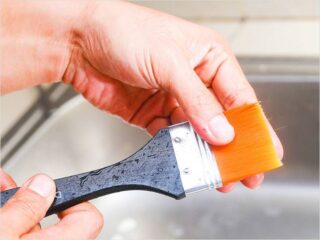
You will need the following tools:
- thin paint brush;
- pressure roller;
- scissors;
- rubber spatula;
- stable stepladder.
Necessary materials:
- finishing putty;
- primer;
- selected paint;
- fine sandpaper;
- sponge;
- containers for solution and washing tools.
In order to comply with safety precautions, work should be done in rubber gloves and goggles.
Preparatory work
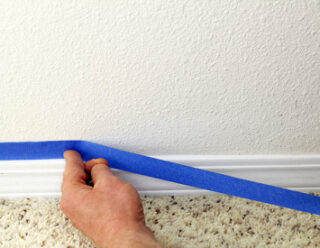
Before applying the finishing finish to the lamellas, the following preparatory measures must be carried out:
- Conduct an external examination, identify all problem areas - unfinished joints, cracks, dents, scratches.
- Mix the solution or prepare a sealant, apply the mixture to the recesses with a slight rise above the plane of the planks.
- Rub the joints between the fragments using a rubber spatula.
- Smear the corners with mortar, it is best to do this with your finger.
- Remove excess putty, wait for it to dry.
- Erase the protruding fragments with fine sandpaper.
- Stick masking tape under the lamellas. Press it firmly against the wall with a trowel and roller.
- Remove dust, cover the planks with a primer.
Further work can be carried out after the primer has completely dried.
Ceiling plinth staining technology
Painting skirting boards is a simple and small task. Nevertheless, its implementation must be treated responsibly and carefully so as not to spoil the final result with minor but annoying flaws.
The technology for applying the mixture depends on the stage at which the finishing is made. In all cases, cover the already lined surfaces with masking tape, film, cardboard or newspapers. When dry, the formulations give off a rather pungent odor. Therefore, the work must be done with the windows open; the draft does not affect the quality of the final result.
The most common option is a paintbrush. You should take a product with a natural pile with a width no greater than that of a lamella. The liquid should be grasped at a minimum with the very tip of the brush, then immediately distribute it in horizontal movements, rubbing into all irregularities. The next section must be covered with the capture of the previous one by 5-6 cm. So the coating will be uniform and beautiful.
Another way is to use an aerosol can. Before use, it must be shaken for at least 5 minutes and kept strictly upright during the spraying process. You need to drive the nozzle horizontally, without stopping in one place, so that there are no drips.








